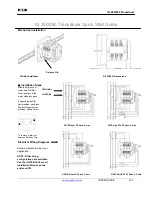
MDS 05-3305A01, Rev. E
MDS 4710/9710 Technical Manual
45
DSP
—Digital Signal Processing. In the MDS 4710/9710 transceiver,
the DSP circuitry is responsible for the most critical real-time tasks; pri-
marily modulation, demodulation, and servicing of the data port.
DTE
—Data Terminal Equipment. A device that provides data in the
form of digital signals at its output. Connects to the DCE device.
Equalization
—The process of reducing the effects of amplitude, fre-
quency or phase distortion with compensating networks.
Fade Margin
—The greatest tolerable reduction in average received
signal strength that will be anticipated under most conditions. Provides
an allowance for reduced signal strength due to multipath, slight antenna
movement or changing atmospheric losses. A fade margin of 20 to 30
dB is usually sufficient in most systems.
Frame
—A segment of data that adheres to a specific data protocol and
contains definite start and end points. It provides a method of synchro-
nizing transmissions.
Hardware Flow Control
—A transceiver feature used to prevent data
buffer overruns when handling high-speed data from the RTU or PLC.
When the buffer approaches overflow, the radio drops the clear-to-send
(CTS) line, which instructs the RTU or PLC to delay further transmis-
sion until CTS again returns to the high state.
Host Computer
—The computer installed at the master station site,
which controls the collection of data from one or more remote sites.
Intrusive Diagnostics
—A mode of remote diagnostics that queries and
commands radios in a network with an impact on the delivery of the
system “payload” data. See
Active messaging
.
Latency
—The delay (usually expressed in milliseconds) between when
data is applied to TXD (Pin 2) at one radio, until it appears at RXD
(Pin 3) at the other radio.
MAS
—Multiple Address System. A radio system where a central
master station communicates with several remote stations for the pur-
pose of gathering telemetry data.
Master (Station)
—Radio which is connected to the host computer. It is
the point at which polling enters the network.
MCU
—Microcontroller Unit. This is the processor responsible for con-
trolling system start-up, synthesizer loading, and key-up control.
Microcontroller Unit
—See
MCU
.
Multiple Address System
—See
MAS
.












































